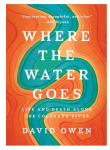Where the Water Goes: Life and Death Along the Colorado River
By David Owen
Riverhead Books, 2017

From its headwaters in the Rocky Mountains to its terminus in the deserts of northern Mexico, the Colorado River is the focus of aspirations, livelihoods, community, controversy, and conflict. A wake-up call in the form of a travelogue, Where the Water Goes explores the river’s history from the days of John Wesley Powell to its current state as the most important water source in the American Southwest. David Owen begins his book near Boulder, Colorado and works his way down to the Mexican border, following the 1,400-mile-long Colorado River and taking numerous side trips, to tell the story of one of the most complex water systems in the world. He exposes the issues that threaten the river, its dependent ecosystems, and its users and explores their complexities, revealing that there are no easy solutions. Additional suggested readings for every chapter are listed in the back.
David Owen is a staff writer for the New Yorker and his book is based on his article “Where the River Runs Dry,” which appeared in the May 25, 2015 issue.
OECD Principles: From Policy Standards to Practice
Edited by Aziza Akhmouch, Delphine Clavreul, Sarah Hendry, Sharon B. Megdal, James E. Nickum, Francisco Nuñes-Correia & Andrew Ross
A Special Issue of Water International, Volume 43, 2018
This publication was a joint initiative by the Organization for Economic Cooperation and Development (OECD) and the International Water Resource Association (IWRA) featuring the work of the OECD’s Water Governance Initiative in framing principles for water governance. The publication provides a showcase for approaches and efforts to use the principles as a tool for complex multi-stakeholder dialogue. Following an introduction to the OECD principles, the papers, which are co-authored by groups of diverse stakeholders involved in the OECD Water Governance Initiative, include the bridging the policy-implementation gap, social learning through stakeholder engagement, assessing water governance practices, and lessons learned from practical applications. The special issue is available at: https://www.tandfonline.com/toc/rwin20/43/1?nav=tocList#
Dramatic Declines in Snowpack in the Western US
By Philip W. Mote, Sihan Li, Dennis P. Lettenmaier, Mu Xiao & Ruth Engel
Climate and Atmospheric Science, Nature Partner Journals, March 2018
A significant portion of water used in the western United States is runoff and infiltration from mountain snowpack. Snow accumulates on mountains in the winter and melts with the coming of warm weather. A comprehensive study analyzing the snowpack at West-wide snow monitoring sites with long records finds that 90 percent of these sites show declines. The percentage of locations showing decreasing trends is increasing dramatically, and averaged across the western United States, the April 1 snow water equivalent has decreased since the mid-1900s by roughly 15–30 percent or 20-40 million acre-feet, or as much as five times Arizona’s total annual water use. The authors found the greatest declining trends in the Pacific states and in locations, like Arizona, with mild winter climate. The full article is available at https://www.nature.com/articles/s41612-018-0012-1
Divergent Trends of Open Surface Water Body Area in the Contiguous United States During 1984 to 2016
By Zhenhua Zou, Xiangming Xiao, Jinwei Dong, Yuanwei Qin, Russell B. Doughty, Michael A. Menarguez, Geli Zhang & Jie Wang
Proceedings of the National Academy of Sciences, March 2018
A recently published study from the University of Oklahoma Earth Observation and Modeling Facility reports surface water trends for the continental United States from 1984 to 2016. The authors analyzed 37,000 Landsat images and generated annual surface water body frequency maps for the past 30 years. The study showed statistically significant decreasing trends in the Southwest and Northwest and statistically significant increasing trends in the eastern United States. Because these divergent trends are mainly driven by climate, they are likely to continue. The PNAS article can be accessed at http://www.pnas.org/content/early/2018/03/20/1719275115.

